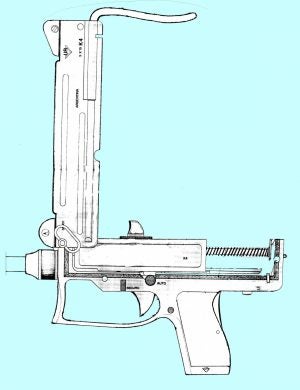The family of very compact submachine guns that came from the creative mind of Gordon B. Ingram starting in the mid-1960s and subsequently series manufactured in the U.S. by the Military Armament Corporation (the .45ACP M10) and the SWD company (the 9x19mm Cobray M11) in the 1970-80 period or so may not have become true operational winners, but their general conceptual idea (“firepower in a very compact package”) did call the public –if not LE and military –attention. As you sure know, this resulted in a large number of close copies appearing in different parts of the world, South America included.
In a recent post here in TFB (https://www.thefirearmblog.com/blog/2017/01/26/msm-compact-subgun-guns-nelmo-suzano/), I was able to share info and pics of a little known Brazilian design dating from 1985. Now, it’s time to show you a totally unknown compact subgun project that emerged in Argentina three years later. The idea came from a local designer called Antonio Ureña, who reportedly worked for the country’s Policia Federal (Federal Police), final plans of which emerged in January, 1988 after some years of laborious in-house studies. Designated the K4, it was a simple 9x19mm open-bolt, blowback-operated selective-fire weapon employing Browning Hi-Power-type magazines of 13- and 36-round capacity. This was certainly a result of that pistol being locally produced by State-owned Fabricaciones Militares for any years.

Compactness of Antonio Ureña’s K4 submachine gun can be clearly seen in the side-by-side comparative drawings with a Browning Hi-Power pistol. This has been manufactured in Argentina as the FM M95 by Fabricaciones Militares for many years.
The main body was a rectangular stamped steel structure, the similar-shaped receiver cover being hinged up to give access to the firing mechanism, bolt and recoil spring so as to allow basic maintenance procedures. Synthetic components were used in the pistol grip/magazine housing area, as well as in the very large trigger guard, which was also given the task of providing some support for the non-firing hand. The fire selector was a sideways-moving button (“AUTO”, “SIMPLE”) just above the trigger, while the applied safety lever (“SEGURO”, “FUEGO”) was located slightly ahead, on both sides. A grip-type safety lever was also incorporated. The cocking piece was on top, and the ejection window, to the right. This was provided with a manually-operated dust cover, which automatically opened when the gun was cocked. Another feature was a retractable, wire-type buttstock.

The weapon with the receiver cover swung open to give access to all the firing components.
A dedicated (K4S) sound suppressor was envisaged, this having its own 207 mm integral barrel and being 227mm long and with a 67mm diameter. It would be attached to the gun’s front mounting collar after removing the original barrel. To my knowledge, the K4 never turned into a real prototype hardware, but maybe Argentine readers might throw some light on that.

Cross-section drawing of the Argentine compact buzzun design.
“Proyecto UR – Pistola Ametralladora K4” – BASIC DATA:
Barrel length: 182mm (6 grooves, RH, 1:380mm); gun length, no stock: 310mm; gun length, closed stock: 325mm; gun length, open stock: 470mm; gun max width, 45mm; height, no magazine: 160mm; height, with 36-round magazine, 277mm; empty weight: 2.3kg.
 Your Privacy Choices
Your Privacy Choices
